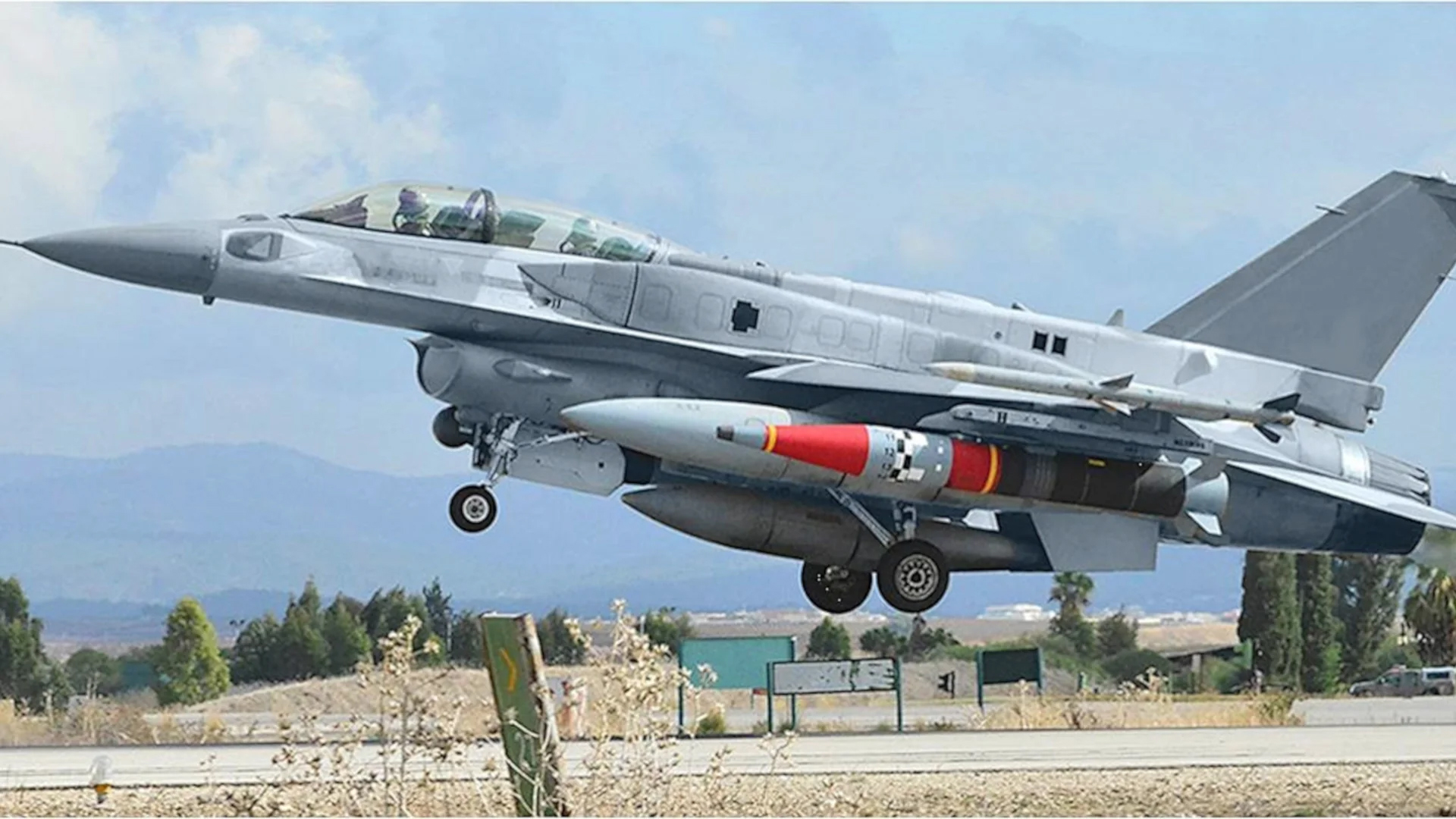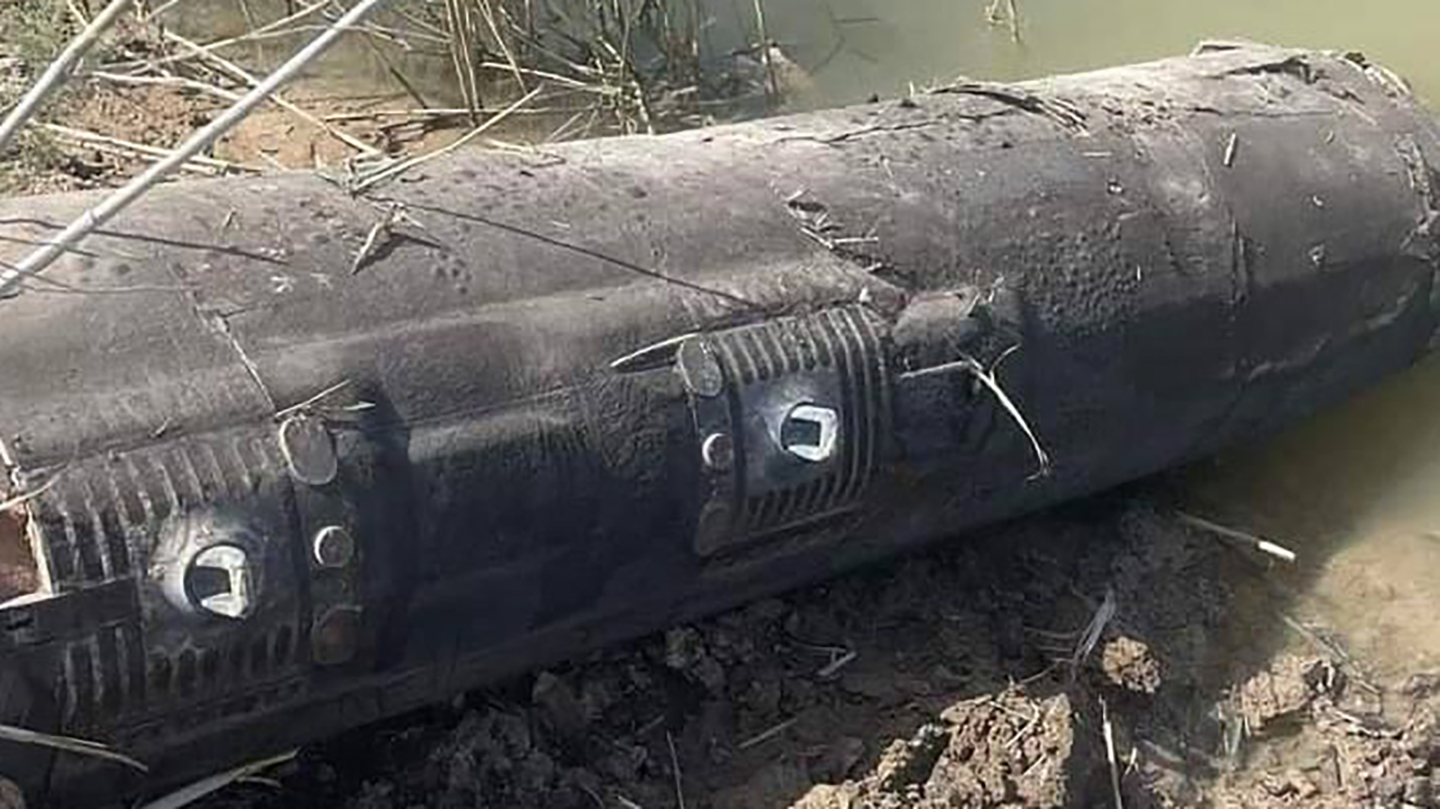The day after a peculiar Israeli attack on Iranian interests, supposedly centering on the airport in Isfahan, although other sites in Iran could have been targeted as well, we are seeing a highly interesting relic that appears to have been left behind in Iraq. We have pored over images available of the missile carcass, and while we find similarities with multiple Israeli weapons, the exact identity of this missile remains unclear, although we have a good idea what it likely is.
Author’s note: This story has been updated with new information that you can check out at the bottom of the article.
Check out the images of the wrecked missile below:
What’s the most visible feature in the imagery is the lug arrangement, where the missile attaches to the aircraft’s pylon. This is often a key identifier of different missiles and bombs, especially advanced ones that can use unique airframe protrusions to harden this area for aerial carriage. In this case, we see two standard lugs, but if you look closely you will see they are mounted on two bulges in the airframe of the missile. Conformal reinforced lug areas are not uncommon, but they can have somewhat distinct configurations.
After viewing the images, the first thing that came to mind is Israel’s Rampage, an air-launched adaptation of the EXTRA guided artillery rocket that we profiled in the past.

In the simplest terms, Rampage is like taking an American M31 Guided Multiple Launch Rocket System (GMLRS) artillery rocket, famously fired by the HIMARS and M270 launchers, and strapping it on a fighter aircraft. The altitude and speed of the launching aircraft can greatly expand the rocket’s range and overall kinematic performance compared to its ground-launched progenitor. In low-altitude release mode, an aircraft flying nap of the earth to avoid enemy air defenses can pop up and launch it, after which it can fly an optimized ballistic-like arc to quickly take out key targets like enemy air defenses. Rampage is a ‘fire and forget weapon’ — after it’s launched, the aircrew can turn and run.
Rampage has an elongated conformal reinforcement area for its lugs, which was part of its adaptation to air-launched applications. Rampage also has rear fins shaped like what we see in the image of the crashed weapon’s empennage. At first glance, this seemed like Rampage, but there is one problem: the elongated bulge area does not match, nor does it protrude far enough back past the rear lug. The missile in the photo has two distinct lug reinforcements and also seems shorter and fatter than Rampage, with lugs that are farther toward the tail than what’s seen on the more slender Rampage.
Rampage also has small canard-like control surfaces on its nose cone. There is an image of a fin section that appears to be broken off that could be this, although it more likely that is part of the tail section that has become detached.

A quick aside on that tail section seen in the crash photos. The empennage looks tapered. This, combined with the shape of the fins and other features we can see, does not align with anything we have know of in Israel’s inventory. Although, it does fit loosely with Ice Breaker, an Israeli cruise missile concept, the developmental state of which isn’t clear. But other features on Ice Breaker don’t match, the biggest being there is no air inlet visible where it should be and it has a thinner body. Also, we don’t even know if this weapon exists in reality at this time.

Upon closer examination of the photos, it looks like the nozzle area may have been crushed to some degree, which makes sense as it is the weak, open end of the missile body. The impact and collapse out of round could give it a tapered look. Still, tapering of the tail section, especially on ballistic missile-like types, is a well established design trait.
With all this in mind, the general shape of this weapon would point more directly toward it being Rocks, which is an air-launched ballistic missile we also profiled in the past that was developed from Israel’s line of Sparrow ballistic missile test targets. Similar to Rampage, Rocks benefits from air launch, especially at high altitude and speed, giving it far better reach than if a similar weapon was launched from the ground. While Rampage would be a good choice for taking out enemy air defenses closer to the Iranian border, Rocks would be a good choice for hitting targets deeper inside Iran, even somewhat fortified ones. Its high speed and maneuvering trajectory make would make it very hard to intercept too, especially with the capabilities that Iran has on hand. It uses GPS/INS navigation and electrooptical seeker that can also be coupled with an anti-radiation seeker for improved terminal guidance, especially against air defense sites.

The lug locations are much more in line with Rocks, but we don’t know if this weapon uses the conformal reinforcement area for its lugs. Imagery of its Sparrow family of predecessors do point to this being the case, but with some noticeable differences among variants. But Rocks is likely to have been optimized when it went into production as an offensive weapon, and streamlining these areas and optimizing the design for serial production techniques could have been a key factor in such revisions that may have resulted in what we see in the images.

It is also possible that this could be one of the Sparrow ballistic missile surrogates, such as Black Sparrow, and was being used as a decoy to stimulate Iranian air defenses. Not only can this be done to distract Iranian forces, but paired with electronic surveillance, this would allow Israel to ascertain Iran’s current electronic order of battle, including the location of their air defense systems, as well as other critical intelligence about their defenses and contingency plans. This would be a critical operation and right in line with Israel’s long history of using decoys for this purpose, if a follow on and much larger strike were in the works or being considered. We must stress that this is simply a possibility and it does not mean Israel is about to execute further kinetic operations against Iran, but the supposed use of drones in Isfahan also raises this exact same concern. You can read all about this possibility in our original coverage on the strike here.
More powerful multi-stage versions of Sparrow are now available, which would provide enhanced range, performance and survivability, both as a decoy and if the type was adapted for strike applications. The booster, having detached and fallen away, would look something like the crash we see in the photos.
While we posit that this is likely Rocks or one of its family members, there is the possibility that this is something new. Israel has many tricks up its sleeve and this very well could be one of them. A more advanced Rocks with a powerful second stage would certainly be new. At the same time, there is also the possibility that this is a ballistic projectile previously fired by Iran or its proxies and has just been discovered now. Lugs can be used to crane missiles that are ground launched too.
So, our best guess is this is a variant of Rocks, although that is not a conclusive analysis. It’s possible we will get more imagery that will help us make definitive conclusion.
UPDATE: 3:30PM EST—
It is now clear that Israel did hit an Iranian air defense site, seemingly one of its prized S-300 batteries, at the air base in Isfahan, and with pinpoint accuracy. New York Times reports the weapon was fired outside of Israeli and Iranian airspace and it was specifically used to thwart Iranian air defenses, and thus the strike was planned to send a message.
This fits perfectly with Rocks, or at least a version of it. The evidence is growing now that this was the weapon employed, including the very target it attacked. Drones could have been launched from even inside Iran and used to stimulate Iranian air defenses at the base, which would have given an anti-radiation seeker-equipped Rocks a perfect target to home in on, increasing its probability of kill drastically even if its GPS was severely disrupted. The presence of drones, or an EW/cyber attack that made them appear to be present, would also distract air defenders from the opposite end of the threat spectrum, an air launched ballistic missile.
Contact the author: Tyler@twz.com
